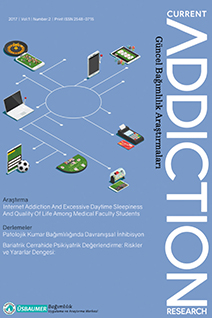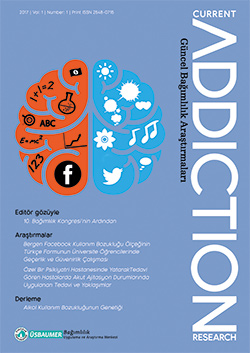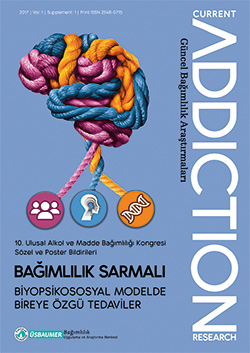Years
2025
Categories
Authors
ARTICLES
Original Article
Azize TÜRKOĞLU,Cemal Onur NOYAN
2025, 9(1), s:5-14
Objective: The aim of this study is to examine the relationship between exam anxiety levels and smartphone addiction levels of secondary school students.
Method: This study was designed using the relational survey model from quantitative methods. The population of the study consists of students studying at the secondary school level in Istanbul between 2023-2024. The sample of the study consists of 417 students selected by simple random sampling method. In the study, Personal Information Form was used to evaluate demographic characteristics, ‘Westside Test Anxiety Scale’ was used to measure the level of test anxiety and ‘Smartphone Addiction Scale-Short Form’ was used to measure the level of smartphone addiction. The research data were analysed using SPSS 27.00 package programme.
Findings: It was determined that there was a positive, weak-medium significant relationship between test anxiety levels of secondary school students and smartphone addiction. In addition, it was determined that there was a significant relationship between test anxiety level and gender, parental attitude, school achievement, parents' attitude towards success, and duration of smartphone use. It was determined that there is a significant relationship between smartphone addiction and time alone, duration of smartphone use, school achievement, parents' attitude towards success.
Conclusion: There is a significant relationship between test anxiety and smartphone addiction in adolescent secondary school students. This indicates that there is a need for prevention studies and psychoeducation for students, teachers and parents in secondary schools for test anxiety and smartphone addiction.
Original Article
Self-Efficacy Against Substance Abuse Risk: A Study on Vocational School Students
Özge Kutlu,Dilan Erkan,Sevinç Sütlü
2025, 9(1), s:15-22
Objective: Although substance addiction is a significant problem that is widespread among young people and threatens public health, it is seen that the protective factors related to the issue have not been examined sufficiently. This study aimed to determine the self-efficacy of vocational school students regarding protection from substance addiction and related factors.
Method: The research is a descriptive and cross-sectional study. The research was conducted with 506 students studying at a vocational school. In line with the purpose of the research, “Personal Information Form” and “Substance Addiction Protection Self-Efficacy Scale” were used as data collection tools. Frequency distribution and variance analysis were used in the analysis of the data.
Results: 77.5% of the 506 participants who participated in the research were female and 22.5% were male. A statistically significant relationship was found between the participants’ self-efficacy regarding protection from substance addiction and the variables of gender, age, program of study and place of residence (p<0.005).
Conclusion: In order to increase the self-efficacy of vocational school students in protecting themselves from substance addiction, a course on combating addiction should be added to the curriculum, structured early intervention programs should be developed, and student communities and social support mechanisms should be strengthened.
Review Article
Abdullah TÜRKMEN
2025, 9(1), s:23-34
In recent years, addiction research has emphasized that substance use behavior should not be understood solely through biological mechanisms, but rather through multidimensional frameworks that include psychosocial and cultural variables. The aim of this review study is to comparatively examine the impact of addiction theories on Turkish individuals living in Turkey and Europe, with attention to their sociocultural contexts. The study was designed as a qualitative meta-analysis, and a systematic review of publications from 2010 to 2025 was conducted using databases including ULAKBİM, DergiPark, Scopus, and Web of Science. Selected studies were analyzed through theoretical frameworks such as Cognitive Behavioral Therapy (CBT), Social Learning Theory (SLT), psychodynamic, and biological models. Thematic analysis indicated that addiction in Turkey is primarily shaped by cultural norms and social learning processes, whereas Turkish immigrants in Europe are more affected by factors like discrimination, language barriers, and identity conflicts. Group therapy and culturally adapted interventions have been found to offer sensitive and effective responses to these challenges. The findings underscore the necessity of developing culturally sensitive clinical models that integrate dynamics of identity, belonging, and social exclusion.
Original Article
Başak Ünübol,Gizem Akülker,Berhudan Şamar,Kursad Nuri Baydili,Selim Arpacıoğlu
2025, 9(1), s:35-42
İntroduction: Research has identified many characteristics that may influence women's progression from use to addiction and their struggle with recovery. In previous studies, it was reported that 2.9-3.2% of the applicants to addiction treatment centers in Turkiye were women. Considering the low rate of women applying to treatment compared to men, it was thought that examining the completion of treatment would make an essential contribution to the literature. At the same time, there is no recent study on the descriptive characteristics of women in inpatient addiction treatment centers in our country and the factors affecting treatment completion.
Method: Our study was conducted by examining the data of 104 female patients who were treated as inpatients with a diagnosis of alcohol or substance use disorder according to DSM-5 in an Addiction Detox Clinic of a Mental Health Hospital. During inpatient treatment, withdrawal severity is assessed according to the type of substance, and the necessary detoxification medication is administered according to the CIWA-R or COWS scales. All participants completed the Addiction Profile Index (API) scale. The data were analyzed using the SPSS-27 package program. Frequency tables for sociodemographic questions were created. Regression analysis was applied to see the effect of the independent variable on the dependent variable. The analyses were applied with alpha level = 0.05.
Results: The mean age of the participants was 31.5 years, the primary substance of use at the time of admission to treatment was alcohol at 45% and substance at 55%, and the frequency of use was every day at 93%. Having a family history of alcohol or substance abuse was 49%. 47% were single, judicial history was 37%, 73% were unemployed, 59% had a history of comorbid mental illness, 35% had a history of suicide attempts in the past, 54% of the participants had multiple substance use, and 22% had a history of intravenous substance use, even if only once in their lives. The early discharge rate was 38%, and sociodemographic and clinical variables were not statistically significant. It was observed that the API scale was statistically highly correlated with non-completion of treatment, especially in individuals with high 'severe craving' sub-dimension scores.
Conclusion: Considering that women have a low rate of applying for addiction treatment, it is important to understand the needs of women patients who apply for treatment to complete the treatment and to include gender-specific intervention programs in the treatment.



 2. Sayı
2. Sayı
 1. Sayı
1. Sayı
 Ek Sayı
Ek Sayı







